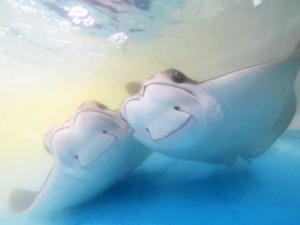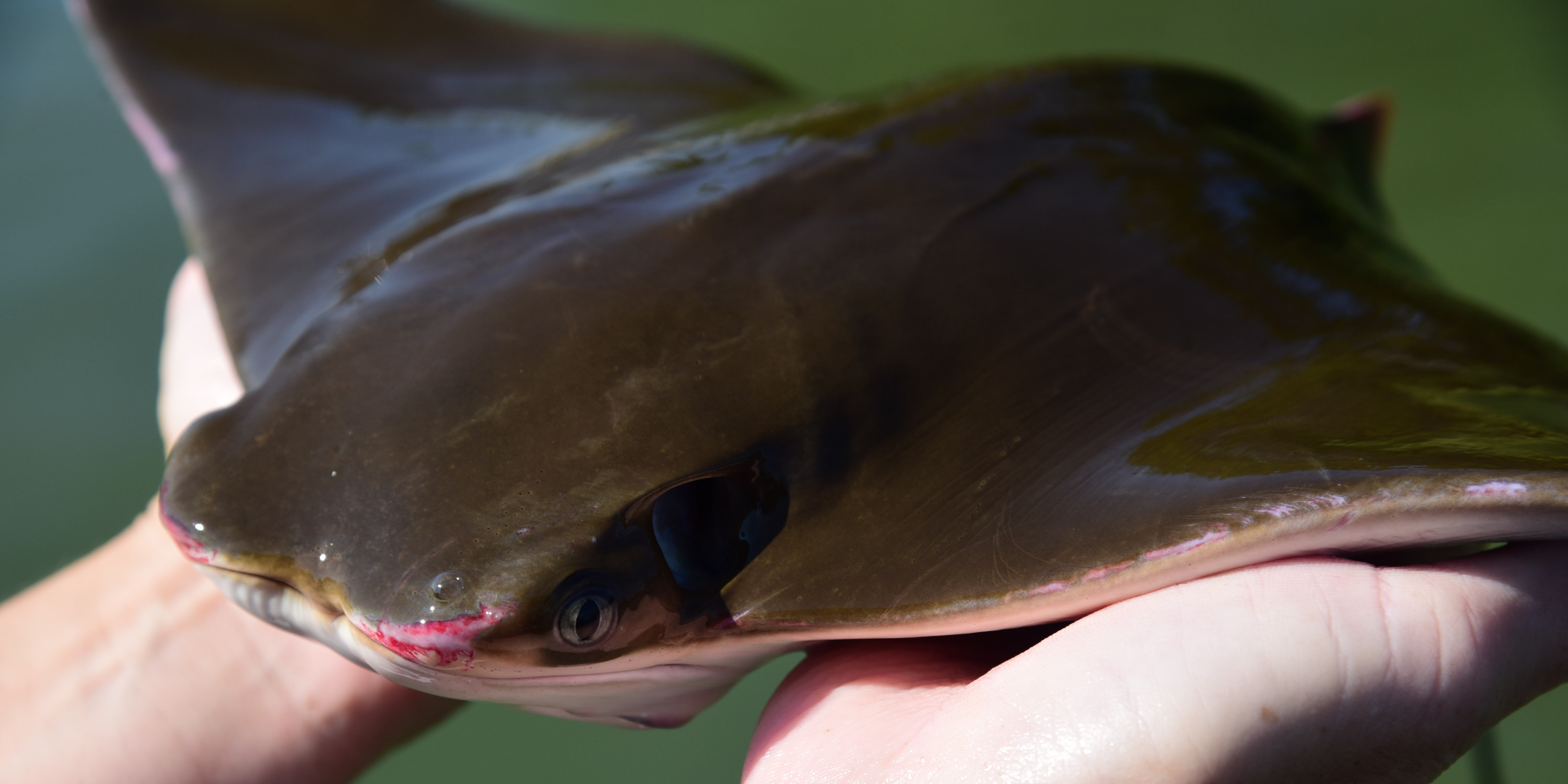
Cownose rays are migratory animals that come into the Chesapeake in summer and swim to Florida for the winter. (Credit: Jay Fleming/Smithsonian)
by Marissa Sandoval
While most students around the country are returning from summer break, some schools stay in session year-round—those under the sea, that is. Schools of marine organisms will migrate great lengths in search of food, breeding grounds, or safety from predation. So unless you want to be left behind, attendance is mandatory for migratory marine animals.
Luckily, some animals have migratory cues that prompt them to depart en masse. The charismatic cownose ray (Rhinoptera bonasus) is one of them.
In a new study published Sept. 9 in the journal Ecosphere, researchers led by Chuck Bangley and Matt Ogburn at the Smithsonian Environmental Research Center (SERC) and Robert Fisher at the Virginia Institute of Marine Science (VIMS) pinpointed which variables cue the rays to and from their summer and winter homes. What’s more, male and female rays may respond to different cues to leave their winter habitat in Florida. Meanwhile, at the end of the summer, both sexes travel together—though climate change may affect their future travel plans.
Misunderstood Migrants
Cownose rays get their name from their distinct square face that looks just like a cow’s snout. Each summer, cownose rays migrate to the waters of the Chesapeake Bay. They can reach a width of over three feet, with a tail nearly twice the length of their kite-shaped bodies.
“They have an interesting duality to their reputation among the public. They’ve been villainized and disliked by fishermen because when a fisherman runs into a big school, that’s a whole lot of bycatch to pick out of the net,” said Bangley, lead author and a former SERC postdoc now at Dalhousie University. “But at the same time, cownose rays are popular aquarium animals. They look like they’re smiling.”
Rays are subtle movers—so much so that they’re often mistaken for sharks. Swimming close to the surface of the ocean, a wing breaking the water looks just like a shark’s dorsal fin to folks on the beach.
No one knew exactly where the rays were coming from each year, until researchers from SERC and VIMS discovered their winter habitat in Cape Canaveral, Florida. By studying the rays, scientists hoped to learn more about their migratory patterns and behaviors.
Their discoveries could have crucial implications for the future of the rays. The scientists hope the study will aid in the creation of a fishery management regulation for the rays in the Atlantic. New findings are especially pertinent since the rays remain particularly vulnerable to climate change and hunting due to their slow life histories. Cownose rays can live for over 20 years. But with an average of six years to reach maturity, if they are over-harvested it would take the population a long time to recover.
“Bowhunting is a big concern since it’s not regulated,” said Michelle Edwards, a former SERC intern on the project. “Since the rays travel as schools, they may be easier to target, allowing some hunters to take a lot of rays out at once.” Maryland is currently drafting what could be the first cownose ray fishery management plan on the U.S. East Coast.
To make the situation even more delicate, mature females only give birth to a single ray, called a pup, each year. Some hunters aim to shoot the largest ray, which are typically pregnant females.
Working with the Rays
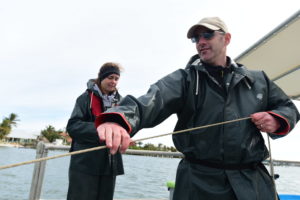
SERC marine ecologist Matt Ogburn (front) and intern Claire Mueller search for bull sharks and cownose rays near Fort Pierce, Florida, in January 2018. (Credit: Jay Fleming/Smithsonian)
The female rays, many of which are pregnant, arrive first in the Chesapeake in early June. They’re seeking a shallow tributary to give birth, where it’s relatively safe for their young to mature.
A couple weeks after the females reach the bay, the males come up for the mating season. You can usually tell a male from a female since he’ll be a little smaller and seemingly eager, splashing about a female. This means that once a female gives birth, it’s not long before her gestation period begins all over again. Mature females can be pregnant for over 11 months of the year!
Access to the rays themselves for tracking their movement isn’t as easy. Smithsonian researchers have partnered with commercial fishermen who accidentally find cownose rays in their bycatch.
What follows is a tested method of inserting an acoustic tag that’s unique to a given ray.
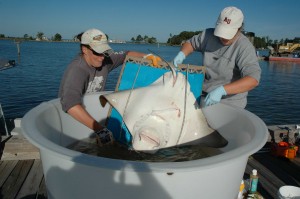
Keira Heggie and Kim Richie, technicians with SERC’s Fisheries Conservation Lab prepare a cownose ray for tagging. (Credit: SERC)
The technicians will turn a ray upside-down so the animal enters a state called “tonic immobility.” In this state, almost like hypnosis, the researchers insert a unique acoustic tag, needing only to apply local anesthetic.
“It takes less than a minute to go into this state. They’re calm and breathing in a deep state of relaxation. You lightly hold them while the surgery happens,” said Edwards.
After the insertion, the researchers check to make sure the rays swim well. They monitor them in wading pools, watching their heads bob above the waterline to check out their surroundings. To date, the researchers have tagged 117 rays.
Then it’s back to the bay for tracking. Acoustic telemetry arrays throughout the Eastern seaboard record and transmit ID info from the tags whenever a ray swims within half a kilometer of the telemetry receivers, thereby following the rays’ movements.
Why and Where the Rays Migrate
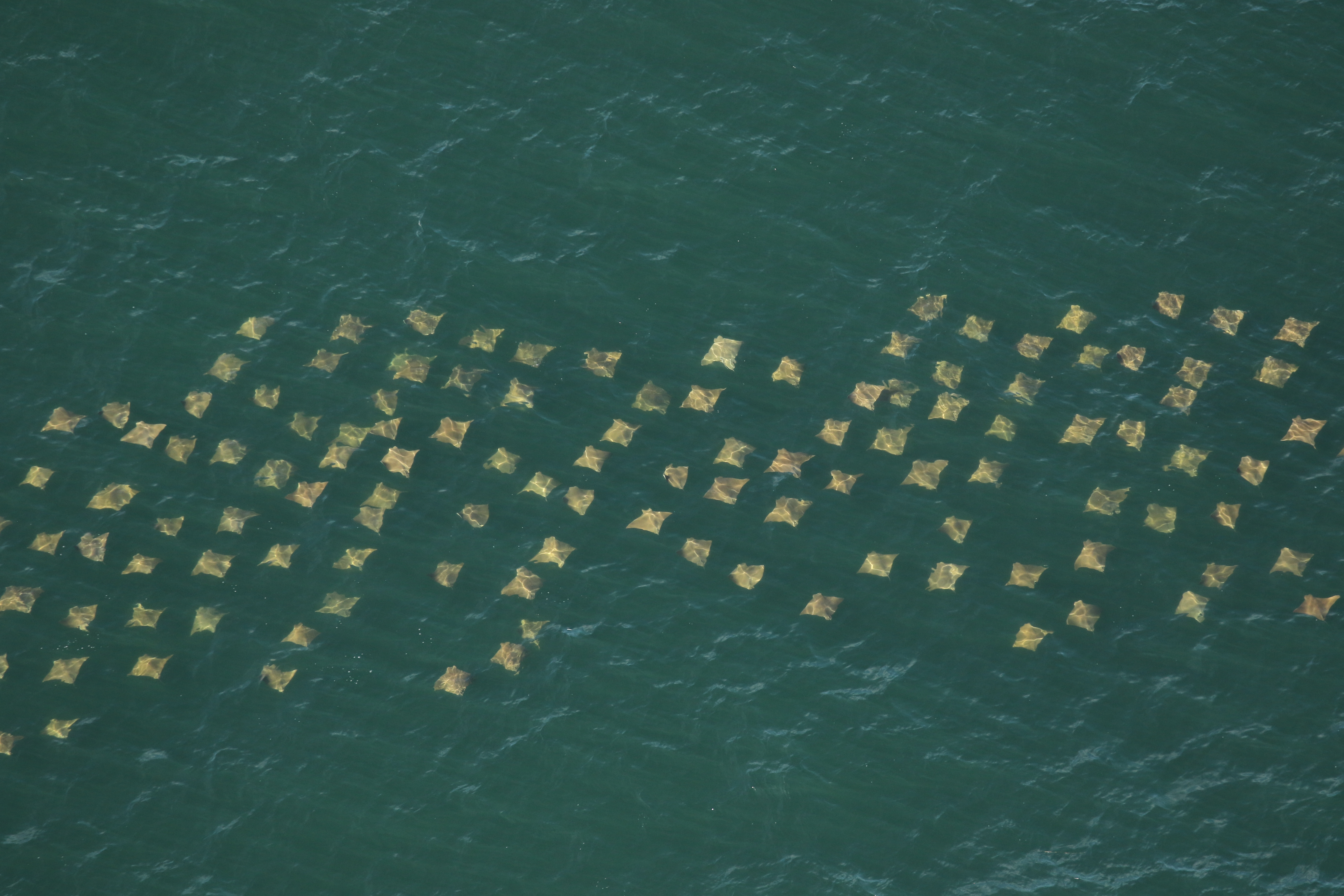
Migration of a massive school of cownose rays. (Credit: Florida Fish and Wildlife Conservation Commission. CC License)
Over the years, researchers found that the temperature of the sea’s surface is tied to when the rays leave the Chesapeake Bay at the end of summer. Both males and females typically migrate together on their journey from the Chesapeake to Florida’s Cape Canaveral.
However, at winter’s end, males and females don’t leave Florida at the same time. Researchers think the sea surface temperature again prompts female rays to head north (just like their southward departure from the Chesapeake). But males’ timing aligns better with recurring calendar days each year, perhaps suggesting they might be using internal physiological cues.
“We’re interested in the effects of climate change on the cownose rays,” said Matthew Ogburn. “We think that if it warms up earlier in the season and stays warmer, the animals might stay in the bay for a longer period of time.”
But there’s another possibility: With warming global temperatures, scientists predict that the rays may push even further north, to cooler regions of the ocean.
Further research will determine how the cownose rays will respond. But if Option B proves true, it will be increasingly important to make sure these schools of slippery predators stay protected.
This study is part of the Smithsonian’s Movement of Life Initiative. Researchers from Florida Atlantic University’s Harbor Branch Oceanographic Institute and Herndon Solutions Group, LLC also participated in the project.
Read the full study at https://esajournals.onlinelibrary.wiley.com/doi/10.1002/ecs2.3743.
Go deeper:
For The First Time, Biologists Track Cownose Rays to Florida and Back
Tracking the Bay’s Cownose Rays
Videos: Following the Movement of Life – Tagging Sharks and Rays

